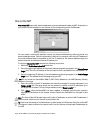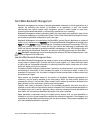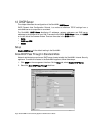
Advanced Features Page 163
Update to apply the changes to the SonicWALL. Now that you have enabled Bandwidth
Management, you can begin configuring Rules to use bandwidth management.
See Bandwidth Management at the end in this section for more information SonicWALL’s Bandwidth
Management features.
TIP! Traffic inbound from the WAN to the LAN/DMZ based on a Rule using bandwidth management
is allowed as if there is no bandwidth management in place. However, outbound traffic (reply
packets) for traffic associated with an inbound Rule is managed based on the configuration for that
Rule.
DMZ/WorkPort Link Settings
Specifies the speed and duplex mode of the Ethernet connection to the DMZ/WorkPort link. The
default selection is Auto Negotiate because the Ethernet links automatically negotiate the speed
and duplex mode of the Ethernet connection. The other choice, Force, with lists for speed and
duplex, should be used only if your Ethernet card also forces these settings. You must force from
both sides of your connection to enable this setting.
LAN/HomePort Link Settings
Specifies the speed and duplex mode of the Ethernet connection to the LAN or HomePort link. The
default selection is Auto Negotiate because the Ethernet links automatically negotiate the speed
and duplex mode of the Ethernet connection. The other choice, Force, with lists for speed and
duplex, should be used only if your Ethernet card also forces these settings. You must force from
both sides of your connection to enable this setting.
Proxy Management workstation ethernet address on WAN
If you are managing the Ethernet connection from the LAN side of your network, this check box can
be selected. The SonicWALL appliance takes the Ethernet address of the computer managing the
SonicWALL appliance and proxies that address onto the WAN port of the SonicWALL. If you are not
managing the SonicWALL appliance from the LAN side, the firmware looks for a random computer
on the LAN creating a lengthy search process.
MTU Settings
A network administrator may set the MTU (Maximum Transmission Unit) allowed over a packet or
frame-based network such as TCP/IP. If the MTU size is too large, it may require more transmissions
if the packet encounters a router unable to handle a larger packet. If the packet size is too small, this
could result in more packet header overhead and more acknowledgements that have to sent and
processed.
The default value is 1500 octets based on the Ethernet standard MTU. The minimum value that can
be set is 68. Decreasing the packet size may improve the performance of the network.


















